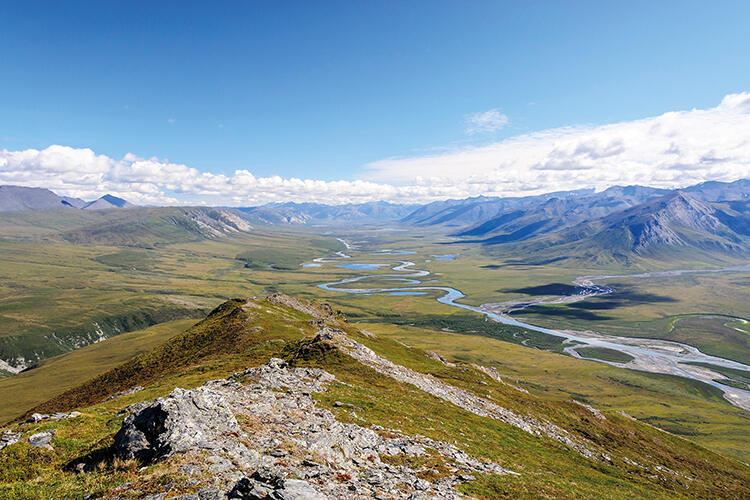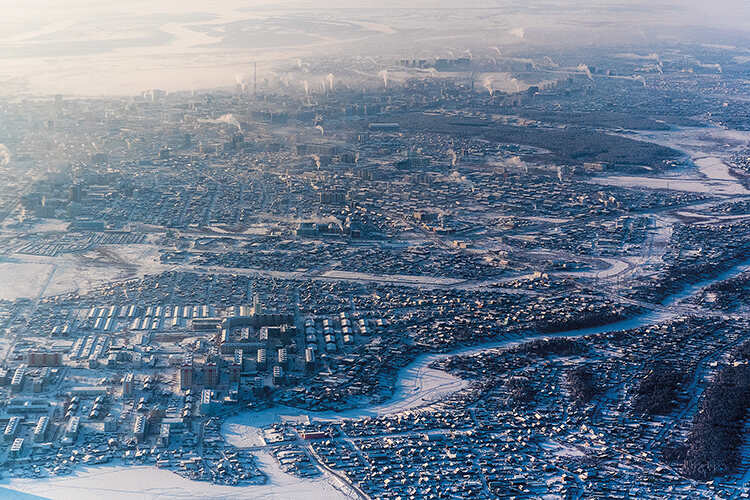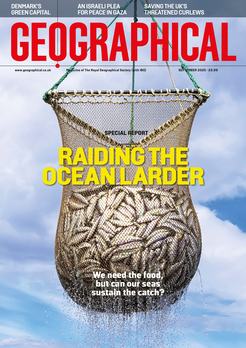
A new study reveals that permafrost plays a key role in shaping, and constraining, the Arctic’s rivers
By
Winters in the lowlands of western Siberia are long and harsh. The sun barely rises and temperatures can dip to minus 40°C, encasing the landscape in darkness and ice. But for a short time during the summer months, sunlight transforms the 2.5 million square kilometres of icy tundra into the world’s largest wetlands. ‘There’s tons of water in Arctic tundra landscapes,’ says Joanmarie Del Vecchio, a geomorphologist and assistant professor at William and Mary University in the US. ‘These places are super wet, you walk around and you’re squish, squish squishing.’
Yet, beneath all the water, much of the ground is still frozen. A quarter of the Northern Hemisphere is covered by permafrost – soil and sediment that has remained below 0°C for a duration of two years or more. Along the length of the Yenisey, one of three rivers that flow through the West Siberian Plain, permafrost is found in 88 per cent of the land, 33 per cent of which is permanently frozen. It’s permafrost, says Del Vecchio, that prevents the summer meltwater from eroding away the Arctic soil.
It was while conducting fieldwork in western Alaska that Del Vecchio first considered whether permafrost might play a role in shaping the Arctic’s rivers, too. She’d noticed that the local rivers seemed to flow across a smaller area than their temperate counterparts. Could permafrost be holding them back, she wondered, and if it is, what might it mean if Arctic landscapes continue to warm?

Together with colleagues at Dartmouth College in the USA, Del Vecchio looked at more than 69,000 watersheds across the Northern Hemisphere using climate and satellite data. Their focus was on upstream tributaries; Del Vecchio describes them as the first little veins in the river system. ‘We found that those channels were smaller and fewer in number in areas where permafrost is present, even in spots where you’d think the force of the water would be enough to start the erosion process needed to become a river,’ she says. It’s the first evidence that shows the Arctic’s frozen soil is the dominant force shaping Earth’s northernmost rivers.
In parts of the Arctic, however, soil temperatures have risen by as much as 2.5°C in the last 30 years and permafrost is starting to thaw. Del Vecchio says that it’s hard to predict what might happen if the landscape begins a cycle of thawing and freezing. She likens the Earth’s surface to one big tug of war between different geological processes, such as the landslides that fill valleys with sediment and the rivers that carve them up again. ‘If things get warm and suddenly river channels start to win,’ she adds, ‘we’re going to see a large amount of carbon get released into the atmosphere.’
Arctic permafrost is thought to store nearly 1,700 billion tonnes of carbon, contained within frozen plant or animal remains. As it thaws, and growing tributaries churn up more Arctic soil, Del Vecchio and her colleagues estimate that every one degree Celsius increase of global warming could release as much carbon as the annual emissions of 35 million cars. ‘That will likely create this warming feedback loop that leads to the release of more greenhouse gases from Arctic permafrost,’ she says.

Further downstream, there could be other consequences for Arctic communities. If river networks begin to expand in the headwaters, erosion will bring more sediment down from the hinterlands to the flatter floodplains. More than eight million people live in the watershed of the Yenisey River. A million live alongside the Lena, another river that runs through the Siberian plain, including the 270,000 residents of Yakutsk, the world’s largest city to be built entirely on permafrost. ‘People set up shop next to rivers, assuming that they’re not going to change,’ says Del Vecchio. ‘But rivers that fill with sediment tend to jump their banks.’
Currently, the researchers are still digging into the data to try to understand whether we might expect to see changes in some areas sooner than others. ‘In places like western Alaska, which is a bit warmer, the permafrost isn’t continuous – it looks a bit like Swiss cheese. You might expect places like this that are already warm to be closer to their tipping point,’ says Del Vecchio. ‘But maybe it’s the coldest places where, once you start to poke holes where there haven’t been any before, change will happen really fast.’ Despite these uncertainties, she’s positive that recent technological advancements, which have allowed more scientists to study the Arctic remotely and in more detail, will lead to more discoveries soon. ‘I would like to think we will be on a quick upward trend in terms of Arctic research. We’ll need to be,’ she adds, ‘because there’s not a lot of time left to figure it out before we run into trouble.’




